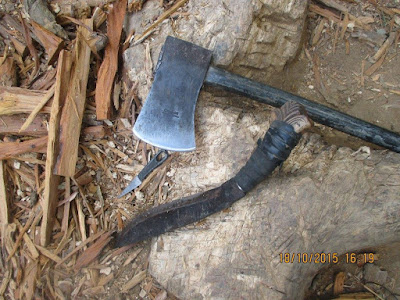WISDOM TRAILS: There is no "Perfect Knife". A knife could not do all things safely even if it has a very skillful owner. You need a certain knife for a certain kind of work and vice versa.
First seen in Facebook
September 24, 2018
=> => => o0o
<= <= <=
I TRIED MY BEST TO HAVE the perfect knife in my whole life, the one knife that could do it all, but I simply could not hold on to it (as a teaching model) and I failed. Despite the skills learned the hard way, it was not enough. I may succeed but I may double my effort if in case I was cutting a large branch with a folding knife or lose my poise if I was carving something delicately small with a machete.
However, I have seen local mountain
kids with their bolos, longer than their femur bones, who effortlessly used
these as if they were handling a small blade. I watched Tata Kasoy, the
venerable elder of the Pastolan Aeta, who nonchalantly whistled and talked in
broken English while deftly creating things out of bamboos with his long panabas as if it was an extension of his
arm.
The skills with a blade are earned. You may achieve something but at a cost of breaking the blade somewhere along the way or ruining your project. There should be blades dedicated for brute force and blades for delicate jobs and then the blades in between. George Washington Sears have solved that by creating a system to handle different works. People later called it the “Nessmuk Triumvirate” in his honor.
Quite practical and this system ensures that you would not break your one and only blade. The system creates a redundancy favored now by modern bushcraft enthusiasts which is fail-safe. That idea of the perfect knife disappears and replaced by a perfect mental state where you have an almost unlimited option to approach each problem with a different blade.
In Philippine bushcraft, the best big
blades to use are those that are made locally. They are tested by time and the
most frequent materials used against it are the wiry types of vegetation like
cane grass, vines and the very deceptive bamboo. These type of blades could
chop any wood found in the tropics like Tata Kasoy’s panabas. These blades are valued by their owners and most of them
are heirlooms.
Nessmuk was referring about his pocket knife as the least component of his system. Quite clearly, by its build and make, it was used for light work like peeling fruits, slicing thin strips of meat, and smoothing out the rough edges of wood that his bigger blades missed. When it came to pocket knives, or folding knives, we choose the imported ones and, many, come with so many extras.
The blade in between the big and the small, could be any make. Local and imported blades compete for the attention of our local bushcraft enthusiasts here. The real guys, those that go out regularly doing dirt-time, prefer those that were made by here or carry the cheap imported types. Why? They are not there to impress but to develop their craft.
Since outdoors activity now are more leisurely, bushcraft here shunned the large blade and replaced it with a folding saw, thus lessening the weight you pack. We gave more teeth to the saw by increasing the size of the pocket knife with a bigger Victorinox which has a tiny saw. Compensating for the loss of the big blade are two medium-sized blades and a baton stick foraged for the occasion.
=> => => o0o
<= <= <=
WARRIOR PILGRIMAGE BLOG, personified by this writer, is synonymous with the Outdoors, since Bushcraft and Survival is its niche. Safety and Security are its bedrock when it ventured into organizing outdoor events that involved people as in adventure/pilgrimage guideships and seminars; and explorations and expeditions.
Through tutorship, experience, folk
knowledge and good old common sense, this writer was able to collect useful
information which he is currently documenting in a book titled, ETHICAL
BUSHCRAFT. He shares some of this information and knowledge in his training
sessions; in his social-media account; and in this blog.
Image
Nr 1 courtesy of City Sports Club Cebu




































No comments:
Post a Comment